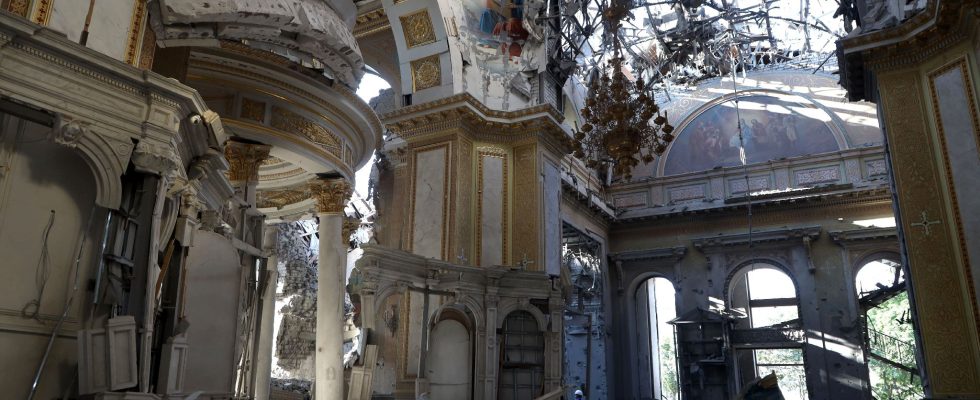In war, the culture and history of a people are also strategic targets. Sunday, July 23, Odessa, this port town planted on the shores of the Black Sea, woke up with historic buildings destroyed and a gutted cathedral. This is the third time this week that the city has been targeted by Russian strikes.
The Transfiguration Cathedral, a majestic Orthodox building of the Church of Ukraine, located in the center of Odessa and listed as a UNESCO World Heritage Site in Danger since January 2023, was partially destroyed by night bombardments. Built in 1794 and then designated the main church of New Russia, it served as a model for several religious buildings in this region of the world, such as the Nativity Cathedral in Chisinau (capital of Moldavia), before being destroyed for the first time by the Soviets in 1936.
Since the start of the invasion, historic Ukrainian buildings have been the collateral victims of Russian offensives. The Odessa Cathedral was not the only heritage building destroyed last night. “According to a preliminary assessment, several museums located within the World Heritage site suffered damage, including the Archaeological Museum, the Fleet Museum and the Odessa Literature Museum,” said the UN organization for culture, science and education. “All had been marked by Unesco and the local authorities with the Blue Shield, the distinctive emblem of the 1954 Hague Convention” for the protection of cultural property in the event of armed conflict, which was therefore “violated” in Odessa, denounced Unesco. “This war poses a growing threat to Ukrainian culture,” the organization insisted.
Theaters, museums and statues destroyed by the hundreds
According an official Unesco count stopped on July 20, 2023, 270 recognized cultural or historical sites have already been damaged since the beginning of the war, on February 24, 2022. Among them, 116 religious buildings, including 12 in the city of Kiev alone. In Chernihiv, the Holy Trinity Monastery, built in 1695 in Ukrainian Baroque style and considered before the war to enter the World Heritage List, was damaged during the siege of the city. The Dormition Cathedral was hit by a cruise missile during the Battle of Kharkiv. It has lost several statues as well as 360-year-old stained glass windows.
The list of listed places damaged by the conflict also includes 27 museums, 95 historical or artistic buildings, 19 monuments, 12 libraries and an archive. There are memorials to Jewish victims of Nazism, schools, statues and art collections. In April, a previous Unesco estimate put the amount of cultural property (partially or completely) destroyed at 2.4 billion euros.
On March 16, 2022, the Mariupol Regional Drama Theater – a cultural hotspot that had served as a refuge for hundreds of civilians since the start of the war – was hit by two bombs. Assessment according to the municipality: several hundred dead. The Russian authorities at the time denied any responsibility and accused the Azov battalion of being responsible. Three days after the start of the war, the museum of Ivankiv, in the oblast of kyiv, was deliberately destroyed by fire. Set on a medieval site dated to the 13th century, it housed the work of nationally recognized artist Maria Pryimachenko. According to the Ukrainian Ministry of Culture, more than 1,000 lesser-known sites and places of culture have been shelled by the Russian army in more than a year.
Many monuments and memorials that cannot be moved, such as statues or fountains, have been protected by the cities or the inhabitants over the course of the conflict, thanks to the laying of sandbags or the installation of wooden structures filled with foam and covered with plastic. In Kiev, about thirty objects are thus wrapped, while in Lviv, whose center is considered an architectural jewel, the foundation for the preservation of architectural and historical monuments documents the work of the inhabitants to protect their history.
Looting or the weapon of the invaders
When culture is not destroyed, looting is also a weapon of war. Within the walls of Kiev, four renowned museums have already been attacked by passing Russian troops: the Khanenko Museum, the Museum of Modern Art, the Taras Shevchenko National Museum and the Natural History Museum. The majority of the collections were able to be sheltered. But experts observe the systematic looting of these buildings by enemy soldiers, who steal the works of art and then ship them to Russian museums. In Kherson, according to the Ukrainian Minister of Culture, “more than 80% of the collections of the two museums” were looted during the occupation. Including several thousand objects (that is to say almost the entire collection) exhibited at the Regional Museum of the city, which was the epicenter of the fighting until November 2022.
Extensive protection work is however being carried out by the country’s authorities. Some works have, for example, been transferred to other countries to be preserved. In mid-November 2022, some 70 paintings had been removed from the National Museum of Art of Ukraine, in Kiev, to be exhibited at the Thyssen-Bornemisza Museum in Madrid, a few hours before the bombardment of their place of exhibition. The other substantive work, led by the International Alliance for the Protection of Heritage in Conflict Areas (Aliph) and Unesco, is to conduct inventories in the hope that looted art will return to Ukrainian institutions when the conflict ends.
In April 2023, Unesco announced a 6.4 billion euro plan to safeguard Ukrainian heritage and finance the reconstruction of the country’s cultural sector.
